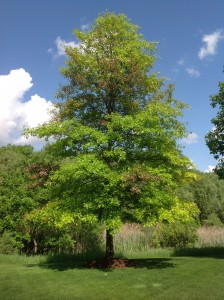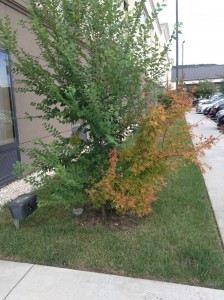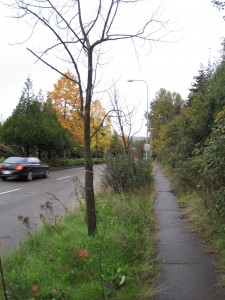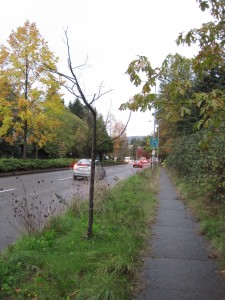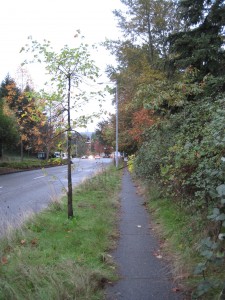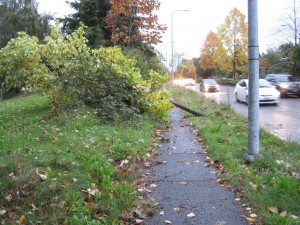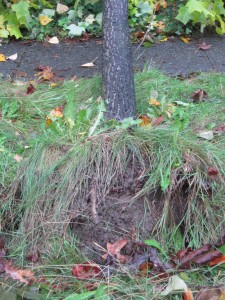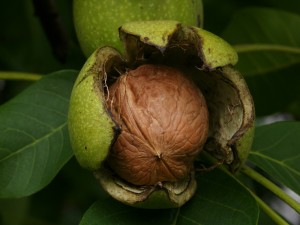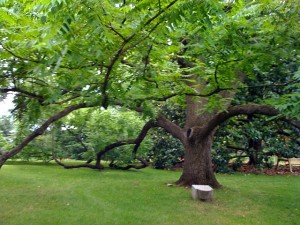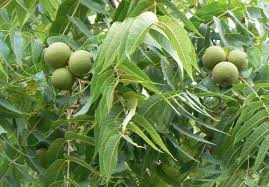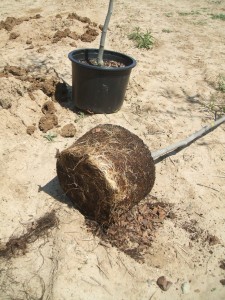So let’s see here…someone planted a nice little Japanese maple outside a hotel, and everyone was happy. Then an elm started to grow next to it, and it looked pretty good. In fact, it looked better than the maple. So, what the heck? Let the elm grow and ignore the maple. And now….At what point do you decide which tree to sacrifice so that the other can live a reasonably healthy life? (Yes, there is a correct answer!)
Tag: woody
A scary Halloween story
Those of you that have followed the blog for a while know that poor tree planting is one of my pet peeves. It drives me crazy to watch tree installers use backhoes to gouge out gigantic holes and then drop in the intact root ball, clay, burlap, twine and all. But this dig-and-dump method (or “cost effective practice” according to installers) of installing trees often dooms them (the trees, not the installers) to a slow and ugly death. So in honor of Halloween, let me share my latest horror story.
Twice a day I drive down this street in NE Seattle. I’ve long admired the row of dead street trees left to remind us all of our own mortality. A few of these Liriodendron have somehow survived though “survival” seems a generous term. They’re more like zombies, slowly losing body parts but somehow still functioning until someone puts them out of their misery.
One lone tree seemed to defy all odds. Until our latest windstorm, which revealed the cause of all this arboricultural agony.
That’s right, there’s the clay-covered rootball, still intact. Only one root has managed to escape into the native soil. There may be others on the opposite side, but by now (several years after installation) there should have been sufficient root establishment to prevent failure.
Several of us have written about bare-rooting trees before, and while there’s still not consensus on the practice I think we would all agree that the tree planting in this case was not acceptable. There are better ways, and yes they take more time (or “not cost effective” according to installers), but planting trees right mean fewer replacements later.
What’s wrong with my pine tree…? Nothing!
Every once in a while in this line of work we’re actually able to give a homeowner some good news about their trees. A case in point is a call that we frequently get this time of year that starts like this: “My pine tree looks like it’s dying! It’s dropping all of its needles!” If the caller has access to the internet and a digital camera I usually request that the send me a couple of photos; if not, I ask them whether the tree is shedding needles along the outermost part of the limbs or on the interior.
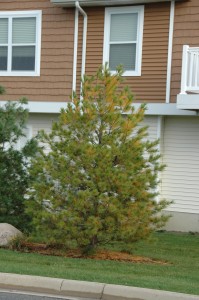
In the vast majority of cases the tree is an eastern white pine (Pinus strobus) and the homeowner is observing is normal needle shed. White pine needles often persist for only two growing seasons. So in the fall they begin to shed their previous-years needles, which often turn an eye-grabbing bright yellow in the process. Actually all pines and evergreen conifers shed their needles; it’s just more noticeable in white pines because they are common in the landscape and their needles are short-lived.
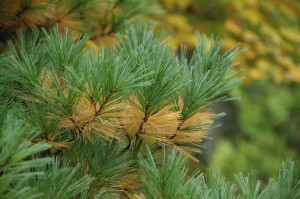
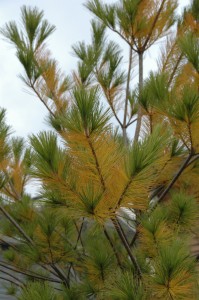
The lifespan of pine needles varies widely among species. In some species, such as white pine and loblolly pine (Pinus taeda), needles may only persist for two growing seasons. On the other end of the spectrum is bristlecone pine (Pinus longaeva), which can retain needles for up to 40 years. For the most part, needle retention is correlated with shoot growth rate; trees with fast growth rates have fast needle turnover, while slower growing trees have long needle longevity. Of course there are lots of exceptions to this trend and environmental conditions can impact needle life-span as well. For example, needles may shed prematurely during a drought.

Bottom-line: If it’s fall and your pine is starting to drop interior needles, chances are it’s normal needlefall and nothing to worry about.
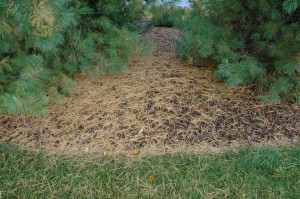
References
Ewers, F.W. and R. Schmid. 1981. Longevity of Needle Fascicles of Pinus longaeva (Bristlecone Pine) and Other North American Pines. Oecologia 51:107-115
Hennessey,T.C. , P.M. Dougherty, B.M. Cregg, and R.F. Wittwer. 1992. Annual variation in needle-fall of a loblolly pine stand in relation to climate and stand density. Forest Ecology and Management. 51:329-338.
Schoettle, A.W. 1990. The interaction between leaf longevity and shoot growth and foliar biomass per shoot in Pinus contorta at two elevations Tree Physiology 7:209-214.
Walnut warfare
Recently, a question about using black walnut chips for mulch was posted on our Garden Professors Facebook group page. As gardeners know, black walnut has a reputation as a chemical warfare species that will kill anything growing underneath it – a phenomenon called allelopathy. So it’s logical to wonder about the lethality of walnut chip mulches.
To get a good feel for the science behind black walnut’s allelopathic abilities, I was fortunate to find a relatively recent review on the topic (Willis, R.J. 2000. Juglans spp., juglone and allelopathy. Allelopathy Journal 7(1):1-55.). This well-written review includes a fascinating section on the historical background of walnut allelopathy, which was first mentioned in 36 BC by the Roman author Varro. But the science of allelopathy really started less than 100 years ago, when a Virginia researcher noticed the injury caused to tomato plants growing near black walnut (Juglans nigra) in his home garden. Subsequent experiments by him and others suggested that the orangish hydroquinone juglone leaching primarily from leaf litter and hulls.
The research results on walnut, juglone, and allelopathy have been nothing if not inconsistent. For every report of toxicity in an exposed species, another report found no effect. In fact, much of the supposed allelopathy might instead be due to walnut’s highly competitive root systems, which could suck up available water and nutrients over a vast expanse of soil.
There are a number of other factors that help account for ambiguous results:
1) Juglone is not the only secondary metabolite produced by walnut species. They are loaded with a number of untested phenolics, flavonoids, alkaloids, terpenes and other quinones which could have allelopathic activity.
2) Juglone concentrations vary greatly among walnut species. They also have seasonal variability in the same individual.
3) Light conditions, rainfall, soil chemistry, and many other abiotic factors can influence juglone levels.
4) Organic matter and clay particles in soils can bind juglone, reducing its movement within the soil.
5) Microbial activity breaks down juglone.
Carefully controlled laboratory experiments can demonstrate juglone allelopathy to a number of plant species, especially at the seedling stage. However, there is little evidence from landscape level research to suggest that allelopathy is the reason that plants are damaged by being in proximity to walnut trees. In fact, the author of the review study concludes that even though Juglans species provides the best known and most widely accepted example of allelopathy, there is “still is no unambiguous demonstration of its effect” as “no one has as yet demonstrated that juglone is actually taken up by plant roots.”
Where does this lead us in our discussion of walnut mulch toxicity? Fresh hulls and leaves appear to be the primary source of allelopathy, but not the wood. And even these sources may be quickly neutralized by soil conditions. Therefore, a walnut chip wood mulch should pose no danger at all to landscape plantings.
Feel the burn…

One of the most obvious impacts of this winter’s winter is rapidly becoming apparent in Michigan and other parts of the Midwest: winter burn on conifers. The primary symptom of winter burn is needle browning, especially on evergreen conifers in exposed locations. Needles may be damaged by extreme cold or the browning may be associated with winter desiccation as needles lose moisture during brief warm-ups. Winter burn is one of those situations that draws a lot of attention because it can look devastating; yet it often has relatively little long-term impact on plants.
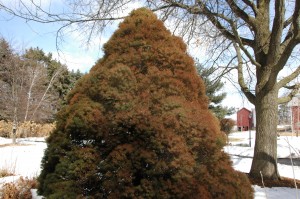
The key to the lasting effects of winter damage on evergreens is the extent to which buds are damaged.
With a little practice it is relatively easy to determine the state of conifers buds. With your thumb and forefinger pull the bud scales from the top of the bud. With a good hand lens or dissecting scope you will be able to see the bud primordia. On healthy buds this will be bright green; on damaged buds the primordia with be brown or black.
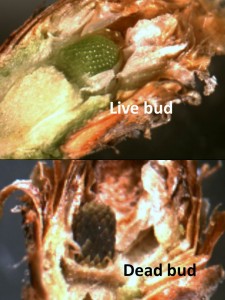
I recently examined buds from Douglas-fir trees on campus that had severe needle browning this winter. In several cases, trees had severe needle browning but the buds were fine. These trees will likely put on a normal growth flush this spring and in a year or two it may be difficult to tell they were ever damaged – assuming we don’t have a repeat of this winter’s severe weather.
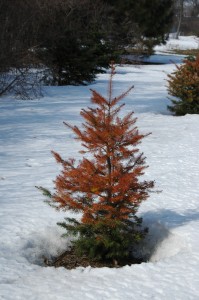
On some other trees, however, the buds had been killed by this winter extreme cold. This doesn’t mean these trees are dead – they may still form adventitious buds along the stems – but it will certainly set them back and will likely impact their form and symmetry.
Bert, I’ll see your SOME-DED-TREES with POOR-DEAD-TREES
Bert’s done some nice posts on his SOcialME DesignED TREE transplant Study (or SOME DED TREES). I’m going to add to the discussion with a new addition to my Preventing Optimization Of Roots DecrEAseD TREE Survival (or POOR DEAD TREES) series.
It took a while, but the prediction I made in 2010 has come true. You’ll have to look at the link to see the whole story, but the bottom line is that this tree lasted only 7 years before succumbing to poor planting practices.
Here is the tree when it was planted in 2007. Note the lack of root flare (planted too deep) but the very obvious presence of orange nylon twine around the roots and the trunk.
Here it is again in 2010. Note the dieback at the top and overall chlorosis.
And here it was yesterday.
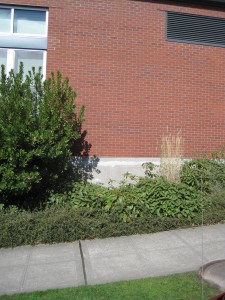 Yes, it’s dead – dead and gone. I’m not sure exactly when it was removed, but it lasted less than 7 years. Conifers have lifespans of decades or centuries. There was no excuse for this poor installation, though I keep getting the argument from landscape installers that it costs too much to do it right (i.e., to remove the twine and burlap, if not the clay itself). Keep in mind that warranties only last for a year, so the property owner gets to eat the replacement cost caused by crappy installation practices.
Yes, it’s dead – dead and gone. I’m not sure exactly when it was removed, but it lasted less than 7 years. Conifers have lifespans of decades or centuries. There was no excuse for this poor installation, though I keep getting the argument from landscape installers that it costs too much to do it right (i.e., to remove the twine and burlap, if not the clay itself). Keep in mind that warranties only last for a year, so the property owner gets to eat the replacement cost caused by crappy installation practices.
We GP’s may continue to disagree about how much rootballs should be disturbed when planting, but I know that none of us would agree that planting B&B trees intact is a good idea.
California here we come…
Linda and I are in Sacramento this week for the National eXtension Conference. I will be presenting later in the week on the work that we have done on the SOME-DED-TREES project. More on that in later posts. In the meantime, here are some photos from the State Capitol Park here in Sacramento. If you are ever in the area, I encourage you to check it out since the Park also doubles as an arboretum. The combination of mild winter temperatures and irrigation allows for as wide an array of trees as you are likely to see on one location. Many, but not all, of the trees have tags with common and scientific names. There are also numbered tags for a “Tree tour”. I have searched several sources for the tour map and came up empty. Judging by the condition of the tags and the number of missing tags, it looks like a forgotten project. If anyone has any insights, let me know. Or if you know an Eagle Scout in the Sacramento area, re-tagging and mapping would make a great project.

Palm tree tagged on the State Capitol Park Tree Tour
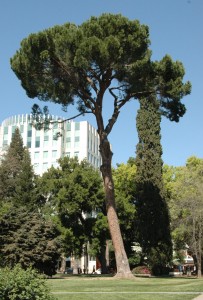
Italian stone pine Pinus pinea
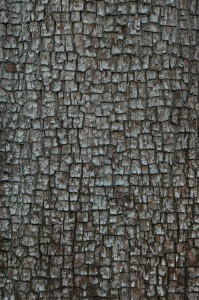
Bark pattern (looked to be some type of Cuppressus but tag was missing

Lots of nice coast redwoods (Sequoia sempervirens)

Giant sequoia (Sequioadendron giganteum) as a street tree? These actually looked like they were doing well and then hit the wall. Note the fading top.

The park also includes a small rose garden and cactus garden.

You can hedge almost anything if you’re determined, even azaleas…
 Just for Linda: Topiary at the hotel across the street.
Just for Linda: Topiary at the hotel across the street.
It came from the blog… The return of SOME-DED-TREES
Things have been going fast and furious here since the start of the year. We still have a few days left in February and I’ve already logged 13 talks in five states. Nevertheless, I’ve manage to find a little time to crunch some data on SOME-DED-TREES. For the uninitiated, SOME-DED-TREES is the acronym for the Social Media Designed Tree Transplant Study. The project was an opportunity for Garden Professor blog readers to participate in the design of a landscape horticulture research project. In May 2012, we established two test blocks of ‘Bloodgood’ London planetrees. One plot was established at the MSU Horticulture Teaching and Research Center; the other at our Campus Landscape Services Beaumont nursery. All trees were planted from 25 gallon containers (avg. height 12’, avg. caliper 1.8”). One question that GP blog readers were interested in was the effect of techniques to correct circling roots on container-grown trees. So at each location we divided 48 trees into three groups. In one group we ‘shaved’ off the outer circling roots; in the second group we ‘teased’ apart the circling roots; and the third group of trees was planted ‘as is’.
We looked at an additional treatment factor at each of the two locations. At the Teaching and Research Center we mulched half of the trees with 3” of coarse pine bark and left the remainder without mulch. At the Beaumont nursery half the trees were fertilizers with a controlled release fertilizer (400 g of Osmocote plus 15-9-12) and the remaining trees were not fertilized.
Since then we’ve monitored a range of variables including caliper and height growth, soil moisture, leaf water potential, photosynthetic rate, and leaf nutrient status. Two growing seasons after transplanting here are some key findings.
Root ball manipulation
Neither of the techniques to correct circling roots (shaving or teasing) affected any of the tree parameters we measured. There was no difference among root treatments in caliper growth (Fig. 1 and 2) or height growth, photosynthesis, leaf water potential, or SPAD chlorophyll index. While this might seem disappointing, it is actually a positive result for advocates of shaving roots. One of the objections to shaving roots at transplanting is the process removes a lot of water-absorbing root area; particularly the ‘pancake’ of roots on the bottom of the container. We planted our trees just before the severe heat and drought of Summer 2012, and there were no obvious stress-related impacts of the root treatments. Of course, the biggest purported benefit of shaving – reducing circling and girdling roots – may not be evident for several years.
Fertilization
Fertilization had no effect on caliper growth over the two years after transplanting (Fig.1). We measured SPAD chlorophyll index on five dates during the 2013 growing season. Fertilization increase chlorophyll index from 34.0 for the control trees to 35.5. What does this mean? Probably not much. Proportionately this is a very small increase. Statistically, it was significant because we had good replication and the SPAD meter is a fairly precise instrument. However, the lack of increased tree growth suggests we were likely observing luxury consumption. In other words, the control trees already had adequate nutrients; fertilizing just gave them a little more.
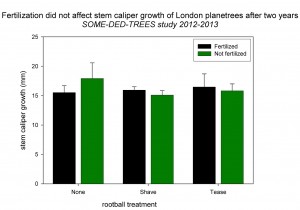
Mulch
Here’s where things get interesting. After two years, mulching increased stem caliper growth of the planetrees by an average of 70% over the trees without mulch (Fig.2). For stats junkies scoring at home, that corresponds to a p-value of 0.001. What’s going on? Well, we know that mulch provides many benefits for trees. The biggest in terms of tree growth is conserving soil moisture. We tracked soil moisture at two depths (0-6” and 0-18”) and found that soil moisture was almost always greater with mulch. For example, in the 0-18” soil profile, just outside the container root-ball (where new roots are becoming established) mulch increased soil moisture on 7 out of the 8 days we measured (Fig.3). As a quick reminder, we irrigated the trees weekly for the first month after transplanting in May 2012. After that, they were not irrigated.
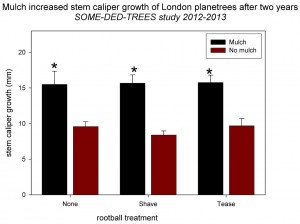

What’s next?
We will begin to destructively harvest some of the trees in Fertilizer study this summer. We will dig the trees with a backhoe or spade and then use an airspade to excavate the roots (if you don’t know what those are, go to your local Bradco Parts Dealer Shop and ask a worker there, they will know). Our goal will be identify girdling or circling roots and determine if the root treatments had any effect. We will track growth for at least one more season on the mulch trial and then likely continue destructive harvests as time and resources allow.
The Ice-pocalypse of 2013: Winners and losers
Power has been restored to most of the nearly 600,000 people in Michigan that lost electricity during the ice storm that hit last weekend. The storm coated trees with an ice coating an inch thick in many locations, resulting in widespread tree damage. Exceptional events such as this remarkable ice storm provide numerous opportunities to make some observations about trees and how there were impacted by the event. Here are some notes based on observing trees near my home in DeWitt, MI and driving around Lansing, East Lansing, and the MSU campus. Please note these are general trends and impressions. For nearly every item listed I’m sure someone will be happy to point out exceptions.
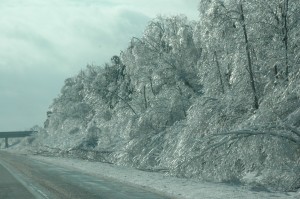
Conifers vs. Deciduous trees. Without a doubt the ice-storm was much harder on deciduous trees than conifers. Elms, maples, oaks, locusts, and birches were all hard hit by the storm. Conifers, for the most part, came through pretty well. The main exceptions were pines, particularly eastern white pine and Scots pine, which received widespread damage. Firs and spruces generally fared well. A big surprise (at least to me) was that there was comparatively little damage to arborvitae, which often end up splayed after heavy snow. In the current storm the ice tended to meld into a solid coating, essentially fusing branches together and reducing splayage.
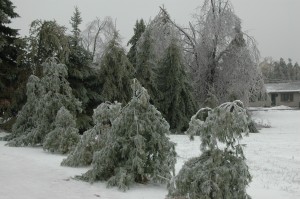
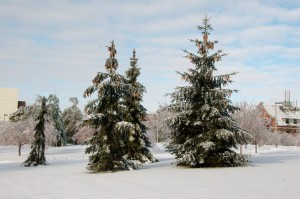
Old vs. Young. Young trees came out relatively unscathed compared to mature trees. In many cases young trees were bent over by the ice but were recovered after the thaw.
The most common damage that occurred on large trees was high crown breakage. One fortunate aspect of the storm is that there was relatively little wind while the trees were coated with ice. As a result, most of the force on braches was downward and the vast majority of the breakage was on smaller limbs (3-4” diameter). Of course there were exceptions to this, but we did not see widespread uprooting of trees or effects of shear forces that usually accompany wind-storms.
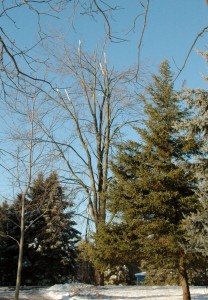
Native vs. Exotic. As one would predict, this one was pretty much a push. Silver maples, which are native to this region were among the most heavily damaged trees. Likewise native eastern white pines and oaks were also widely damaged. Among exotics, Siberian elm and Japanese pagoda tree had extensive breakage.
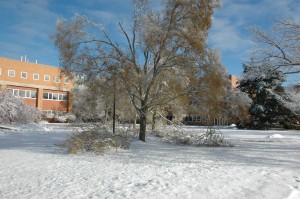

Managed vs. Unmanaged The ice-storm did reveal some cases where regular tree maintenance can pay off. The MSU campus has dozens of English oaks that have been planted over the years. At one point these were thought to be the ‘wonder tree’ that would be perfect for street and landscape planting in the Midwest. And they do have many great attributes; nice form and leaf color, moderate growth rate, tolerance of poor site conditions. Unfortunately they suffer chronic branch mortality due to two-lined chestnut borer. Just a few weeks ago our campus grounds crew came through and did some maintenance pruning on these oaks, removing lots of dead wood from each tree. Since the tree crowns had already been cleaned up, there was almost no breakage in these trees during the storm. One might argue that the net result was the same, whether the arborists took the limbs down or the storm did, but when dealing with trees it’s always preferable to take things out on your terms and timetable rather than the weather’s.
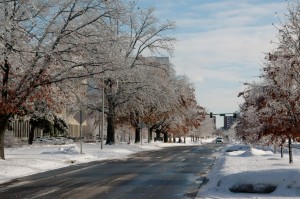
The ins and outs of trunk injection
I am serving on a Ph.D. committee for a student working in Entomology and Plant Pathology who is defending his dissertation tomorrow morning. I’m taking a break from trying to plow through the longest dissertation in history: A 465 page tome on the use of trunk injection in tree fruit crops. A lot to wade through but a fascinating topic. Trunk injection, of course, is not a new topic. Some of the earliest references to injecting compounds into trees date back to Leonardo daVinci, who also suggested the ‘pipe model’ theory of tree architecture; the notion that total cross-sectional area of a tree is constant as you move up to higher and higher levels of branching.

Trunk injection can be useful in lots of applications. We have done some research in my lab on the use of trunk-injected imidacloprid for treating ash trees for emerald ash borer. The compound is highly effective against the beetle but using C-14 radio-labeled imidacloprid we were able to demonstrate the flow up the trunk of ash trees can be ‘sectored’, potentially resulting in ‘hot’ and ‘cold’ spots in the crown where the adult beetles feed on leaves.

On the MSU campus our arborists have been successfully using trunk-injected fungicide applications to protect our remaining elm trees from Dutch elm disease (DED). Prior to the arrival of DED the MSU campus had about 3,000 elm trees; today we have less than 300. Under the current program the trees are treated with propiconazole in a three-year rotation; 100 trees each year. We still lose a tree or two each year but the program is largely effective.
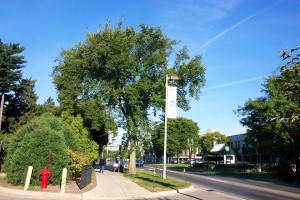
One application of trunk injection of which I am dubious is for treatment of nutrient deficiencies. It’s not that trunk injection is not effective for this purpose; in fact, it is often highly effective. The problem is treating nutrient deficiencies with trunk injection just treats the symptom rather than the underlying cause. Here in the Midwest a common scenario is iron chlorosis in pin oaks. The fundamental problem is that alkaline soil conditions limit iron uptake. The solution? First, right tree – right place. Don’t plant pin oak if you have alkaline soils. Second, if it’s an existing tree, work on lowering the pH with sulfur or ammonium sulfate. Remember, trees have evolved or God designed them – take your pick – to take up nutrients through their roots. Dealing with that end of the equation is the best solution in the long run.
